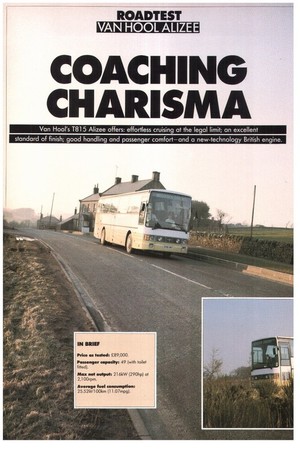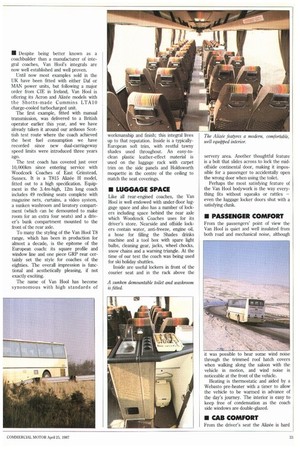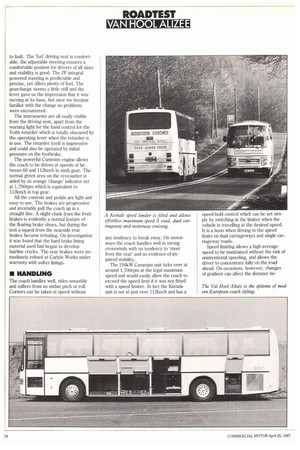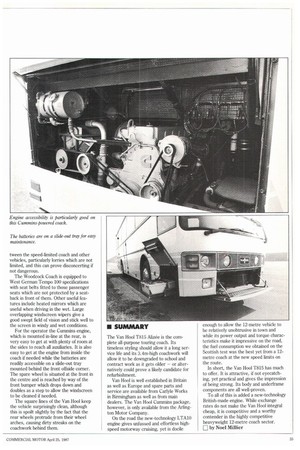COACHING CHARISMA
Page 34

Page 35

Page 36

Page 37

If you've noticed an error in this article please click here to report it so we can fix it.
Van Hool's 181 5 Alizee offers: effortless cruising at the legal limit; an excellent standard of finish; good handling and passenger comfort—and a new-technolo• British en•ine.
• Despite being better known as a coachbuilder than a manufacturer of integral coaches, Van Hool's integrals are now well established and well proven.
Until now most examples sold in the UK have been fitted with either Daf or MAN power units, but following a major order from CIE in Ireland, Van Hool is offering its Acron and Alizee models with the Shorts-made Cummins LTA1 0 charge-cooled turbocharged unit.
The first example, fitted with manual transmission, was delivered to a British operator earlier this year, and we have already taken it around our arduous Scottish test route where the coach achieved the best fuel consumption we have recorded since new dual-carriageway speed limits were introduced three years ago.
The test coach has covered just over 10,000km since entering service with Woodcock Coaches of East Grinstead, Sussex. It is a T815 Alizee H model, fitted out to a high specification. Equipment in the 3.4m-high, 12m long coach includes 49 reclining seats complete with magazine nets, curtains, a video system, a sunken washroom and lavatory compartment (which can be demounted to make room for an extra four seats) and a driver's bunk compartment mounted to the front of the rear axle.
To many the styling of the Van Hool range, which has been in production for almost a decade, is the epitome of the European coach: its square profile and window line and one piece GRP rear certainly set the style for coaches of the eighties. The overall impression is functional and aesthetically pleasing, if not exactly exciting.
The name of Van Hool has become synonomous with high standards of workmanship and finish; this integral lives up to that reputation. Inside is a typicallyEuropean soft trim, with restful tawny shades used throughout. An easy-toclean plastic leather-effect material is used on the luggage rack with carpet trim on the side panels and Holdsworth moquette in the centre of the ceiling to match the seat coverings.
• LUGGAGE SPACE
Like all rear-engined coaches, the Van Hool is well endowed with under-floor luggage space and also has a number of lockers including space behind the rear axle which Woodcock Coaches uses for its driver's store. Nearside and offside lockers contain water, anti-freeze, engine oil, a hose for filling the Shades drinks machine and a tool box with spare light bulbs, cleaning gear, jacks, wheel chocks, snow chains and a warning triangle. At the time of our test the coach was being used for ski holiday shuttles.
Inside are useful lockers in front of the courier seat and in the rack above the servery area. Another thoughtful feature is a bolt that slides across to lock the midoffside continental door, making it impossible for a passenger to accidentally open the wrong door when using the toilet.
Perhaps the most satisfying feature of the Van Hool bodywork is the way everything fits without squeaks or rattles — even the luggage locker doors shut with a satisfying clunk.
• PASSENGER COMFORT
From the passengers' point of view the Van Hoot is quiet and well insulated from both road and mechanical noise, although it was possible to hear some wind noise through the trimmed roof hatch covers when walking along the saloon with the vehicle in motion, and wind noise is noticeable at the front of the vehicle.
Heating is thermostatic and aided by a Webasto pre-heater with a timer to allow the vehicle to be warmed in advance of the day's journey. The interior is easy to keep free of condensation as the coach side windows are double-glazed.
• CAB COMFORT
From the driver's seat the Alizee is hard to fault. The 'Isri' driving seat is comfortable, the adjustable steering ensures a comfortable position for drivers of all sizes and visibility is good. The ZF integral powered steering is predictable and precise, yet offers plenty of feel. The gearchange seems a little stiff and the lever gave us the impression that it was moving at its base, but once we became familiar with the change no problems were encountered.
The instruments are all easily visible from the driving seat, apart from the warning light for the hand control for the Voith retarder which is totally obscured by the operating lever when the retarder is in use. The retarder itself is impressive and could also be operated by initial pressure on the footbrake.
The powerful Cummins engine allows the coach to be driven at speeds of between 60 and 112km/h in sixth gear. The normal green area on the revcounter is aided by an orange 'change' indicator set at 1,700rpm which is equivalent to 112km/h in top gear.
All the controls and pedals are light and easy to use. The brakes are progressive and invariably pull the coach up in a straight line. A slight clunk from the front brakes is evidently a normal feature of the floating brake shoes, but during the test a squeal from the nearside rear brakes became irritating. On investigation it was found that the hard brake lining material used had begun to develop hairline cracks. The rear brakes were immediately relined at Carlyle Works under warranty with softer linings.
• HANDLING
The coach handles well, rides smoothly and suffers from no undue pitch or roll. Corners can be taken at speed without any tendency to break away. On motorways the coach handles well in strong crosswinds with no tendency to 'steer from the rear' and no evidence of impaired stability.
The 216kW Cumin ins unit ticks over at around 1,700rpm at the legal maximum speed and would easily allow the coach to exceed the speed limit if it was not fitted with a speed limiter. In fact the Kienzle unit is set at just over 112km/h and has a speed-hold control which can be set simply by switching in the limiter when the vehicle is travelling at the desired speed. It is a boon when driving to the speed limits on dual carriageways and single carriageway roads.
Speed limiting allows a high average speed to be maintained without the risk of unintentional speeding, and allows the driver to concentrate fully on the road ahead. On occasions, however, changes of gradient can affect the distance be tween the speed-limited coach and other vehicles, particularly lorries which are not limited, and this can prove disconcerting if not dangerous.
The Woodcock Coach is equipped to West German Tempo 100 specifications with seat belts fitted to those passenger seats which are not protected by a seatback in front of them. Other useful features include heated mirrors which are useful when driving in the wet. Large overlapping windscreen wipers give a good swept field of vision and stick well to the screen in windy and wet conditions.
For the operator the Cununins engine, which is mounted in-line at the rear, is very easy to get at with plenty of room at the sides to reach all auxiliaries. It is also easy to get at the engine from inside the coach if needed while the batteries are readily accessible on a slide-out tray mounted behind the front offside corner. The spare wheel is situated at the front in the centre and is reached by way of the front bumper which drops down and doubles as a step to allow the windscreen to be cleaned if needed.
The square lines of the Van Hool keep the vehicle surprisingly clean, although this is spoilt slightly by the fact that the rear wheels protrude from their wheel arches, causing dirty streaks on the coachwork behind them.
• SUMMARY
The Van Hool T815 Alizee is the complete all-purpose touring coach. Its timeless styling should allow it a long service life and its 3.4m-high coachwork will allow it to be downgraded to school and contract work as it gets older — or alternatively could prove a likely candidate for refurbishment.
Van Hool is well established in Britain as well as Europe and spare parts and service are available from Carlyle Works in Birmingham as well as from main dealers. The Van Hool Cummins package, however, is only available from the Arlington Motor Company.
On the road the new-technology LTA10 engine gives unfussed and effortless highspeed motorway cruising, yet is docile enough to allow the 12-metre vehicle to be relatively unobtrusive in town and while its power output and torque characteristics make it impressive on the road, the fuel consumption we obtained on the Scottish test was the best yet from a 12metre coach at the new speed limits on the route.
In short, the Van Hool T815 has much to offer. It is attractive, if not eyecatching, yet practical and gives the impression of being strong. Its body and underframe components are all well-proven.
To all of this is added a new-technology British-made engine. While exchange rates do not make the Van Hool integral cheap, it is competitive and a worthy contender in the highly competitive heavyweight 12-metre coach sector.
by Noel Millier
























































































































